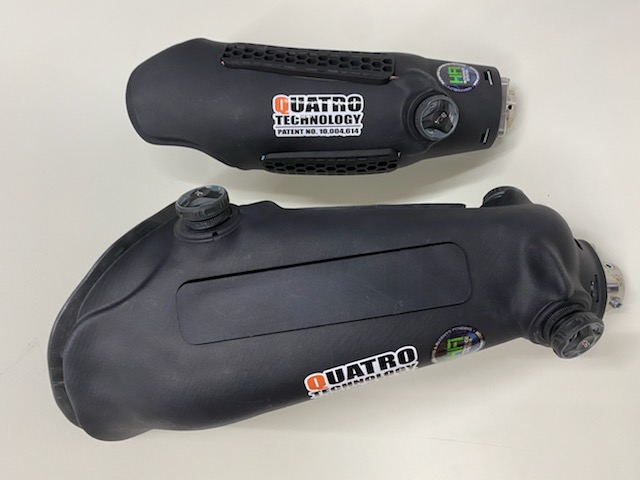
Exhibit A: The Quatro 3D
3D-printed prosthetics raised a lot of hopes when they debuted about a decade ago. But the quest for practical, durable, affordable 3D-printed prosthetics — especially lower-limb prosthetics — has advanced slowly since then, with a lot of promising experiments but no game-changing progress.
Until now?
Meet Joe Johnson, owner of Windsor, Colorado-based Quorum Prosthetics. An RAKA and former Paralympic skier, Johnson took shipment last month of the first 3D-printed prototypes of his company’s Quatro Socket.
“This is the silver bullet,” he says. “It’s really the future. It’s as big as your imagination.”
The Quatro (if you’re not familiar with it) features adjustable side panels that are tightened or loosened via dials on the side of the socket. The model has gotten rave reviews since its debut in 2016 — climber and Outdoor Channel host Craig Demartino swears by them, and former MMA professional Rustin Hughes calls it “the closest thing to my real leg that I’ve ever experienced.” But since it takes 10 hours to custom-build a single socket, Johnson has struggled to scale up his product to the point that it can establish a niche in the market.
BK and AK versions of the 3D printed Quatro
“It takes a toll on our technicians,” says Johnson. “There are many, many steps to manufacture a single Quatro out of a wet-lamination carbon fiber. We build them by hand in our own shop, and it’s extremely laborious.”
Not to mention economically unsustainable. With 3D printing, Johnson can manufacture more quickly and innovate more nimbly. The handful of prototype 3D-printed Quatros he’s received are lighter weight, tighter fitting and more durable than the shop-built specimens.
Here’s how Rustin Hughes, one of the first clients to test-drive the 3D-printed version of the Quatro, describes the transition:
“The biggest thing is that the sockets are built off a 3D scan of your leg. That’s huge. It’s way more precise than the conventional method of making sockets off a plaster cast, because there’s so much variance in your limb while they’re getting that plaster mold. It can change a lot during the process. A 3D scan is way more exact. The other thing I’ve noticed is the 3D prototype is crazy light. Ounces mean a lot in above-the-knee amputees. We exert 30 percent more energy from walking than people with two legs. Having a socket that’s super light, that’s something I noticed immediately.”
Johnson got serious about 3D printing late last year, when an industry colleague urged him to connect with a North Carolina startup called Additive America. He picks up the story:
“I wasn’t thrilled about the idea at first. From everything I had seen in 3D printing previously, I was pretty skeptical. But after I went to their facility and saw their process, that convinced me. They have the expertise to integrate all the components into the socket. The lock can be printed in there, the Boa systems are all integrated. It’s quite amazing.”
“The switch from carbon fiber to 3D printing materials [nylon plus additives] makes the socket a lot lighter. And you can reinforce the socket through finite element analysis. You run a computer test to pinpoint where the stress points are and where it’s at greatest risk of failure, and you fix it before that happens.”
Time will tell if this truly is the silver bullet that slays the 3D printing monster. We’ll be paying attention as the process unfolds.
More Amplitude coverage of 3D-printed prosthetics:
Reinforced 3D-Printed Prosthetic Feet
3D Printing Could Improve Osseointegrated Implants
Prosthetic Foot Advances in 3D Printing Challenge
Open-Source 3D-Printed Prosthetic Hand